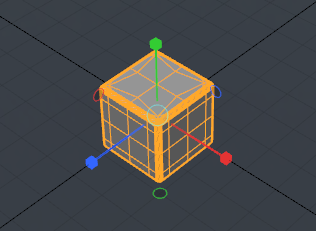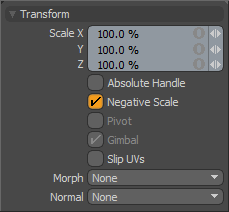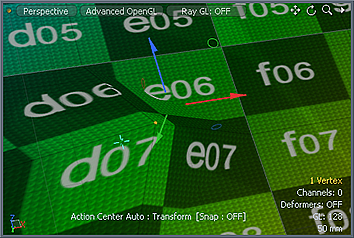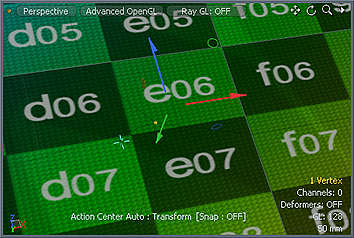
The Scale tool allows users to make any selection larger or smaller by changing the scale percentage factor. By using the various handles the user can quickly scale in a single axis dimension. After applying a transform amount, users may press the MMB to re-apply the previous offset amount, making it easy to apply an edit multiple times. The command can be activated in the 'Basic' subtab of the Modeling viewports, in the menu bar under 'Edit >Transform > Scale' or by pressing the 'R' keyboard shortcut.
In the component modes, 'Vertices', 'Edges', and 'Polygons', the tool affects the selected geometry directly; when nothing is selected, it affects all active foreground geometry. Active foreground items are those that are visible and selected (highlighted) in the 'Item List'. In 'Items' mode the tool affects all the currently selected items in the Item List, if nothing is selected, then the tools will appear to do nothing. In material mode, it works the same way as in any of the component modes. Lastly, in the 'Center and 'Pivot' modes it modifies the Center or Pivots respectively. Note that users will need to physically select either the Center or the Pivot itself, depending on the mode, prior to activating the tool, as in Items mode, with no selection the tool will appear to do nothing.
When users define any of the various Falloffs MODO provides, application of the tool can be attenuated across a user defined area. For more on using Falloffs, please reference the Selection Falloffs page of the documentation.
Once the tool becomes active, MODO draws the relevant tool handles within the viewport. At this point, users may simply click and haul anywhere inside the desired viewport to interactively transform the geometry. Additionally, users may prefer to utilize the various tool handles, constraining the application of the function to one or all three axes. The various tool handles are color coded to match the coloring of the different axes, red for X, green for Y and blue for Z. Hover the mouse over a specific handle until it changes to a yellow color and then LMB-click and drag to modify. To interactively scale the size of the handles themselves, users may use the ' - ' and ' = ' keys on the keyboard to adjust them; minus makes them smaller, while equals makes them larger. Additionally for the Scale tool, there is a small circle at the intersection of all three handles that users can use to uniformly scale the selection interactively.
The Transform tool also respect the settings for 'Action Center', and will originate the action from the defined position. For more information on understanding and using Actions Centers, please reference the Action Center page of the documentation.
 Transform
Transform
Scale: Users may used the X,Y and Z input fields to apply specific scaling values. When adjusting an object interactively in the viewport, the 'Scale' input fields will display the current scale factor applied, providing useful user feedback.
Absolute Handle: The 'Absolute Handle' toggle applies an additional function to the tool handles allowing users to scale the handle itself without affecting the transform amount. In some cases this provides finer control over very large or very small adjustments.
Negative Scale: The 'Negative Scale' toggle enables/disables MODO's ability to interactively apply negative scaling values when manipulating the tool handles in the viewport. When disabled, users can always input negative values in any of the input fields directly.
Pivot: The 'Pivot' setting is grayed out in scale mode as it only applies to rotation and translation transforms.
Gimbal: The 'Gimbal' setting is grayed out in scale mode as it only applies to rotation transforms.
Slip UVs: (Only in Component Modes) UV values are generally fixed to specific vertices, subsequently further edits to the geometry may warp, deform or otherwise distort the UV values in undesirable ways requiring users to adjust the map or redo it altogether. To avoid this undesirable result, users can enable the 'Slip UVs' function so as to not disturb any existing UV mapping applied to the geometry.
 'Slip UVs' function disabled, note texture warping. |  'Slip UVs' function enabled, texture remains even. |
Morph: (Only in Component Modes) The Morph option determines how MODO treats stored Morph information when applying transforms to geometry (Move, Rotate, Scale, etc.). In previous versions of MODO, in order to transform a Morph along with its base, it needed to be selected in the Vertex Map list. If it wasn't, relative Morph map data when recalled would produce distorted, undesirable results. If users were unaware of the requirements, it was easy to accidentally mess up a model. To remedy this problem, there are now three options controlling how the Morph Map vertex data is dealt with when applying any transforms--
None- Unselected Morph data is not affected, though selected (visible) Morphs can still be transformed independent of their source.
Transform- With this option selected, Morph data is transformed along with base mesh.
Keep Positions- With this option Selected, Morph data is converted into a Absolute Morph Map and all vertices retain their pre-transformed positions.
Normal: (Only in Component Modes) When working with Vertex Normal Maps, the 'Normal' options control how the map values are affected (see Transform Normals Tool)--
None- Vertex Normal Map values won't be affected at all by the Transform operations.
Edit- Only Vertex Normal Map values will be modified by the tool and only in the selected Vertex Map.
Update- All Vertex Normal Map values, selected or otherwise, and any selected geometry will be modified by the Transform operation.
Child Compensate: (Only in Items Mode) The 'Child Compensate' toggle when disabled will pass along the transform value to any child items of the current selection, when enabled, the child items will ignore any transform values. This is useful to transform a single item in a hierarchy, such as adjusting a joint, allowing it to be repositioned relative to other elements without moving child items.

The Uniform Scale tool is identical to the normal Scale tool (above), except that users may haul anywhere in the viewport and all three axes are constrained forcing all scaling operating to be uniform. This ensures the mesh will not become distorted when scaling.
 Transform
Transform
Scale: Users may used the X,Y and Z input fields to apply specific scaling values. When adjusting an object interactively in the viewport, the 'Scale' input fields will display the current scale factor applied, providing useful user feedback.
Absolute Handle: The 'Absolute Handle' toggle applies an additional function to the tool handles allowing users to scale the handle itself without affecting the transform amount. In some cases this provides finer control over very large or very small adjustments.
Negative Scale: The 'Negative Scale' toggle enables/disables MODO's ability to interactively apply negative scale values when manipulating the tool handles in the viewport. When disabled, users can always input negative values in any of the input fields directly.
Pivot: The 'Pivot' toggle allows users to easily modify an items pivot position without the need to go into Pivots mode.
Gimbal: The Gimbal setting is grayed out in scale mode.
Slip UVs: (Only in Component Modes) UV values are generally fixed to specific vertices, subsequently further edits to the geometry may warp, deform or otherwise distort the UV values in undesirable ways requiring users to adjust the map or redo it altogether. To avoid this undesirable result, users can enable the 'Slip UVs' function so as to not disturb any existing UV mapping applied to the geometry.
 'Slip UVs' function disabled, note texture warping. |  'Slip UVs' function enabled, texture remains even. |
Morph: (Only in Component Modes) The Morph option determines how MODO treats stored Morph information when applying transforms to geometry (Move, Rotate, Scale, etc.). In previous versions of MODO, in order to transform a Morph along with its base, it needed to be selected in the Vertex Map list. If it wasn't, relative Morph map data when recalled would produce distorted, undesirable results. If users were unaware of the requirements, it was easy to accidentally mess up a model. To remedy this problem, there are now three options controlling how the Morph Map vertex data is dealt with when applying any transforms--
None- Unselected Morph data is not affected, though selected (visible) Morphs can still be transformed independent of their source.
Transform- With this option selected, Morph data is transformed along with base mesh.
Keep Positions- With this option Selected, Morph data is converted into a Absolute Morph Map and all vertices retain their pre-transformed positions.
Child Compensate: (Only in Items Mode) The 'Child Compensate' toggle when disabled will pass along the transform value to any child items of the current selection, when enabled, the child items will ignore any transform values.


